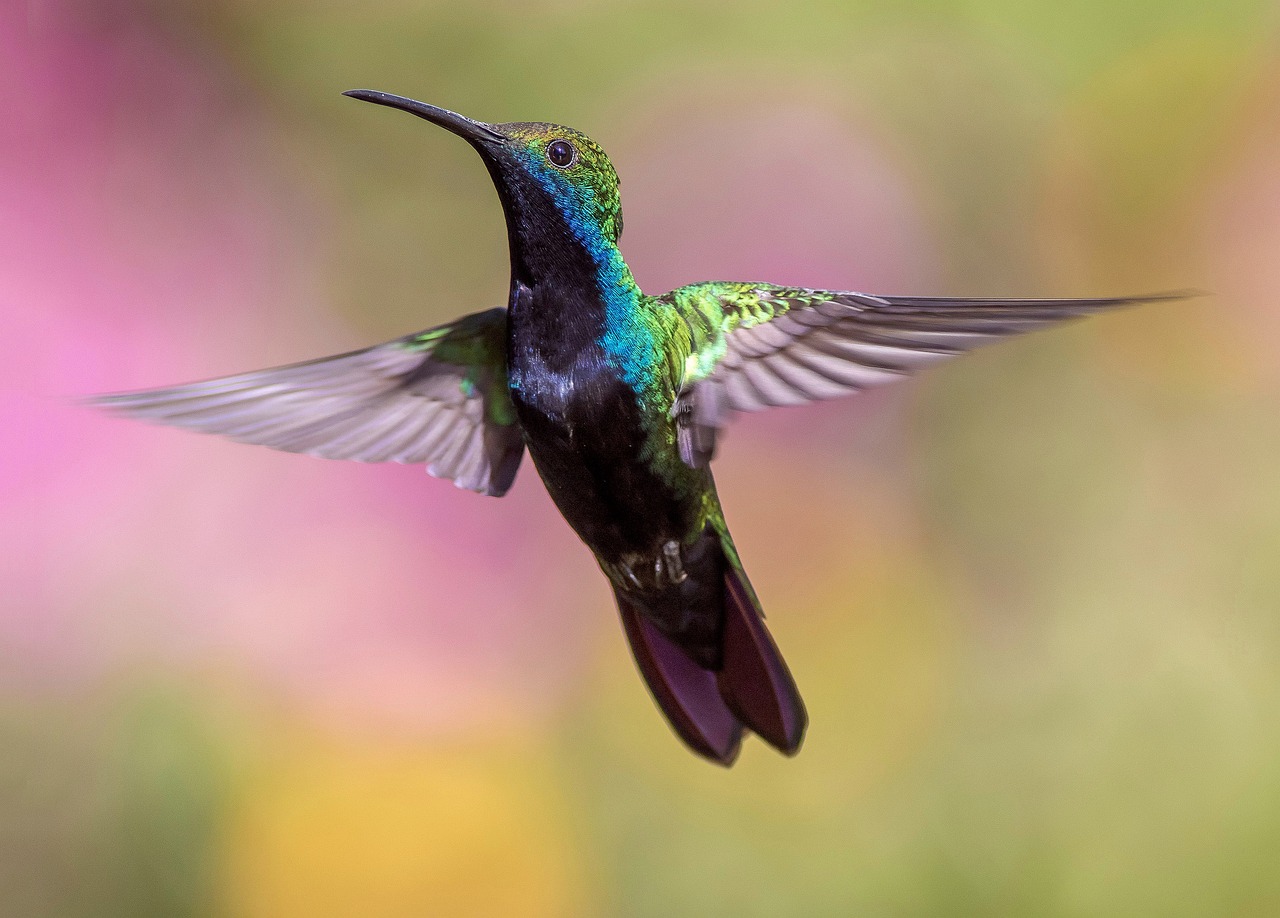Here are 50 interesting hummingbird facts
- Hummingbirds are the smallest birds in the world, with some species measuring only 5.5 cm in length.
- Hummingbirds have the fastest wing beats of any bird, averaging from 10 to 80 times per second depending on the species.
- Hummingbirds can fly in any direction, including backwards and sideways, and can hover in midair by rapidly flapping their wings.
- Hummingbirds have very high metabolisms and need to consume about half of their body weight in sugar every day.
- Hummingbirds feed on nectar from flowers and small insects such as ants, gnats, mosquitoes and wasps.
- Hummingbirds have long, thin bills that can reach deep into flowers to extract nectar. They also have long tongues that can lick up to 13 times per second.
- Hummingbirds have iridescent feathers that reflect light and create dazzling colors. The color of their throat feathers, called gorgets, can change depending on the angle of viewing and the light level.
- Hummingbirds are native to the Americas, where they are found from Alaska to Tierra del Fuego. There are over 300 species of hummingbirds, most of which live in South America.
- Hummingbirds are very territorial and will defend their feeding areas from other hummingbirds and even larger birds such as hawks and jays.
- Hummingbirds can go into a state of torpor at night or when food is scarce, where they lower their body temperature and metabolic rate to conserve energy.
- Hummingbirds have very strong hearts that beat up to 1,200 times per minute when flying and about 250 times per minute when resting.
- Hummingbirds have very good eyesight and can see ultraviolet light. They also have excellent hearing but no sense of smell.
- Hummingbirds are very intelligent and can remember every flower they visit and how long it takes for the nectar to refill.
- Hummingbirds are solitary birds and only come together for mating. The males perform elaborate courtship displays to attract females, such as diving, hovering and flashing their colors.
- Hummingbirds build tiny cup-shaped nests out of plant fibers, spider silk and lichen. They lay one or two eggs that are about the size of a pea.
- Hummingbird chicks hatch after about two weeks and are fed by their mother for another three weeks until they fledge.
- Hummingbirds have very short legs and cannot walk or hop. They use their feet for perching, preening and scratching.
- Hummingbirds have over 900 feathers, the fewest number of any bird species. This helps them reduce weight and increase flight efficiency.
- Hummingbirds have a lifespan of about 5 years on average, but some can live up to 10 years or more.
- Hummingbirds migrate long distances between their breeding and wintering grounds, sometimes crossing oceans and deserts. Some species travel up to 3,000 miles one way.
- Hummingbirds are pollinators and help many plants reproduce by transferring pollen from one flower to another as they feed on nectar.
- Hummingbirds can adjust their wing shape and stroke to cope with different environmental conditions such as wind, rain and altitude.
- Hummingbirds can sense changes in air pressure and use that information to predict weather changes and adjust their behavior accordingly.
- Hummingbirds have very flexible necks and can rotate their heads 180 degrees or more.
- Hummingbirds are very vocal and can produce a variety of sounds such as chirps, squeaks, whistles and buzzes. Some species can even mimic other birds or insects.
- Hummingbirds are attracted to bright colors, especially red, which they associate with nectar-rich flowers. Many people use red feeders or plant red flowers to attract hummingbirds to their gardens.
- Hummingbirds can enter a state of suspended animation called hibernation when the temperature drops below freezing. They can lower their body temperature to as low as 38 degrees Fahrenheit and slow their heart rate to as few as 50 beats per minute.
- Hummingbirds have very weak feet and cannot use them to grasp or carry food. They use their bills and tongues to manipulate food items.
- Hummingbirds are very clean birds and groom themselves several times a day. They also bathe frequently in water or dew, either by dipping into a water source or flying through wet foliage.
- Hummingbirds are among the most aggressive birds and will chase away any intruders from their territory, including larger birds such as hawks, crows, owls and herons.
- Hummingbirds have a special adaptation called a crop, which is an enlarged part of the esophagus that can store nectar. This allows them to quickly drink large amounts of nectar and then digest it later at a slower pace.
- Hummingbirds have no sense of smell but have very good taste buds. They can detect sweet, sour, bitter and salty flavors.
- Hummingbirds are monogamous and mate with only one partner per breeding season. However, they do not form lasting bonds and will seek new mates every year.
- Hummingbirds are very adaptable and can live in a wide range of habitats, from tropical rainforests to alpine meadows. They can also tolerate high altitudes and low oxygen levels.
- Hummingbirds are among the oldest bird groups and have existed for over 20 million years. They evolved from small insect-eating birds that developed long bills and specialized tongues to feed on nectar.
- Hummingbirds have a symbiotic relationship with some plants, such as the century plant and the organ pipe cactus, which depend on hummingbirds for pollination and provide them with nectar in return
- Hummingbirds have a special type of vision called tetrachromacy, which means they have four types of color receptors in their eyes. They can see colors that humans cannot, such as ultraviolet and infrared.
- Hummingbirds can learn to associate colors with food sources and even remember the locations and timing of different flowers. They can also recognize human faces and return to the same feeders or gardens every year.
- Hummingbirds are very sensitive to changes in temperature and humidity and can adjust their behavior accordingly. They can fluff up their feathers to trap air and keep warm, or spread their wings and expose their skin to cool down.
- Hummingbirds have a unique way of sleeping called unihemispheric slow-wave sleep, which means they can shut down half of their brain and one eye while keeping the other half awake and alert. This allows them to rest while still being aware of their surroundings.
- Hummingbirds have a remarkable ability to heal from injuries and infections. They can regenerate damaged feathers, heal broken bones, and recover from wounds and diseases that would be fatal to other birds.
- Hummingbirds have a complex social structure and communicate with each other through vocalizations, body postures, and aerial displays. They can also cooperate with other species, such as bees, butterflies, and bats, to share information about food sources.
- Hummingbirds are very curious and playful and will investigate anything that catches their attention. They have been known to chase bubbles, play with water droplets, and even interact with humans and other animals.
- Hummingbirds have a strong sense of self-preservation and will avoid predators and threats by flying away, hiding, or fighting back. They can use their bills, wings, feet, and tail feathers as weapons to defend themselves or their territory.
- Hummingbirds have a diverse range of vocalizations that vary by species, sex, age, and context. They can produce sounds such as chirps, squeaks, whistles, buzzes, clicks, and trills. Some species can even mimic other birds or insects.
- Hummingbirds have a very low reproductive rate and face many challenges during breeding. They have to find suitable mates, build nests, lay eggs, incubate them, feed the chicks, and protect them from predators and parasites.
- Hummingbirds are very important for the ecosystem as they pollinate many plants that provide food and shelter for other animals. They also help control insect populations by eating them as part of their diet.
- Hummingbirds are threatened by habitat loss, climate change, invasive species, pesticides, diseases, and human activities. Many species are endangered or vulnerable to extinction due to these factors.
- Hummingbirds are admired and revered by many cultures around the world for their beauty, grace, and symbolism. They are often associated with joy, love, hope, courage, and resilience.
- Hummingbirds are among the most studied birds in the world due to their fascinating physiology, behavior
Facebook Comments


































